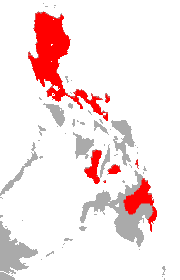
The big red bat is a species of vesper bat from South and Central America.

The Peters's epauletted fruit bat is a species of megabat in the family Pteropodidae. It is found in Angola, Botswana, Democratic Republic of the Congo, Eswatini, Malawi, Mozambique, Namibia, Tanzania, Zambia, and Zimbabwe. Its natural habitat is in riverine or evergreen forest, or moist woodland, where there are fruit-bearing trees.

Behn's bat, Behn's big-eared bat, or Behn's graybeard bat is a species of bat in the family Phyllostomidae found in Brazil and Peru. It is known only from six specimens and is considered rare. It feeds on insects and small fruits.

The dusky leaf-nosed bat is a bat from the genus Hipposideros whose habitat extends from India and Sri Lanka to the Philippines, New Guinea and Northern Australia. This species is counted in the H. bicolor species group and was formerly classified within that species.

The fawn leaf-nosed bat is a species of bat in the family Hipposideridae found in Australia, Indonesia, Malaysia, the Philippines and Vanuatu.
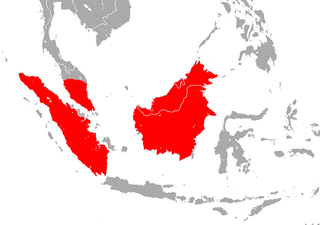
The Borneo roundleaf bat or Bornean leaf-nosed bat is a species of bat in the family Hipposideridae. It is found in Borneo, Sumatra and Peninsular Malaysia. Hipposideros sabanus is a synonym of this species.
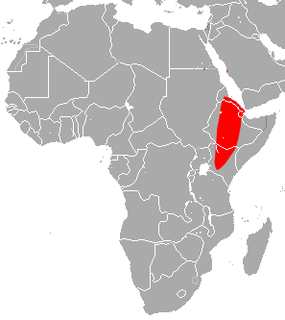
The Ethiopian large-eared roundleaf bat is a species of bat in the family Hipposideridae. It is found in Djibouti, Eritrea, Ethiopia, Kenya, Saudi Arabia, and Somalia. Its natural habitats are dry savanna, subtropical or tropical dry shrubland, caves, and hot deserts.
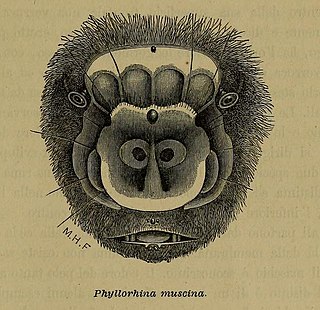
The Fly River roundleaf bat is a species of bat in the family Hipposideridae. It is found in West Papua, Indonesia and Papua New Guinea.

The Biak roundleaf bat or Geelvinck Bay leaf-nosed bat is a species of bat in the family Hipposideridae. It is endemic to the Biak Islands and Cenderawasih Bay area of Papua Province, located in Western New Guinea, Indonesia.

Semon's leaf-nosed bat or Semon's roundleaf bat is a species of bat in the family Hipposideridae. It is found in Australia and Papua New Guinea.

The greater musky fruit bat is a species of megabat in the family Pteropodidae. It is endemic to the Philippines. It was named by Peters for Fedor Jagor.

The acuminate horseshoe bat is a species of bat in the family Rhinolophidae. It is found in Southeast Asia. It lives in forests and urban areas.

The arcuate horseshoe bat is a species of bat in the family Rhinolophidae. It is found in Indonesia, Malaysia, Papua New Guinea, and the Philippines.

The Bornean horseshoe bat is a species of bat in the family Rhinolophidae. It is found in Brunei, Cambodia, Indonesia, Laos, Malaysia, and Vietnam.

Decken's horseshoe bat is a species of horseshoe bat. It is found in Kenya and Tanzania. Its natural habitats are tropica and subtropical moist lowland and montane forest, moist savanna, caves and other subterranean habitats.
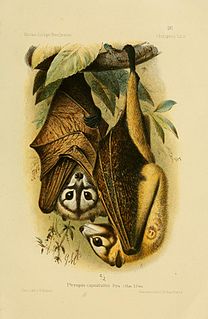
The Bismarck masked flying fox is a species of flying fox in the family Pteropodidae found in Papua New Guinea and named after the Bismarck Archipelago. It was once considered a subspecies of Pteropus temminckii before being reassessed in 2001. This species has two subspecies, P. c. capistratus and P. c. ennisae. The IUCN classified it as Near Threatened in 2009, noting that the rate of decline is almost high enough to reclassify the species as Vulnerable.

Enneapterygius elegans, the hourglass triplefin, is a species of triplefin blenny in the genus Enneapterygius. It was originally described by Wilhelm Peters as a species of Tripterygium, in 1876, but was reassigned to Enneapterygius by W. Holleman in 1986. It is a tropical blenny known from reefs across the western central Indian to the central Pacific Ocean, and swims at a depth range of 0–12 metres. Male hourglass triplefins can reach a maximum length of 4 centimetres. The blenny gets its common name from an hourglass-shaped marking on its body.
